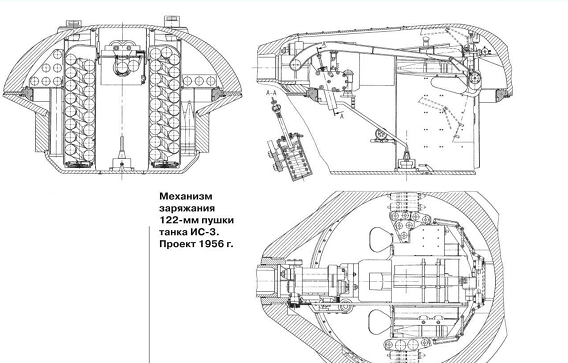Source:http://ritastatusreport.blogspot.nl/2015/03/autoloaded-is-3-short-history.html
来源↗
In mid-50’s, a part of the Soviet army was having a look at their heavy tanks, analyzing their issues and drawbacks. One of the major issues of the heavies was their low rate of fire. The two-piece shells were quite slow to load, resulting in average rates of fire somewhere between 2 and 3 rounds per minute (compared to 6 to 8 rounds per minute of the medium tanks). This was especially true for the 122mm shells of the D-25 gun and ways were sought to remedy the situation.
在50年代中期,苏联军方开始调查自己的重坦了,分析它们的问题和缺点。重坦其中一个主要的缺点是射速太低。分装弹药装填起来太慢,结果就是平均射速只有每分钟2~3发(和中坦的每分钟6~8发比起来还是低了)这个对于D-25炮和122mm弹药来说的确是个很大的问题,他们也就提出了很多用于解决这个问题的办法。
One of the solutions that presented itself during the research was to equip tanks armed with 122mm D-25 with some sort of automatic or semi-automatic loading system. The system however was quite unwieldy and since the loader still had to be present and the turret was not big enough, such a system could potentially lead to the reduction of the amount of ammunition carried.
研究期间其中一个方案是给122mm的D-25炮装上某种自动或者是半自动的装填系统。然而这个系统很笨重,而且装填手依然还需要呆在炮塔里面,而炮塔现在又不够大了,所以这样的系统有可能会导致载弹量的降低。
The use of the electro-mechanic rammer on the T-10 made the life of the loader much easier and it had other advantages as well – the gun could be for example loaded while elevated up to 28 degrees – but failed to significantly increase the tank’s rate of fire – with the two-piece ammunition, it stayed relatively low (4 rounds per minute).
T-10上所使用的机电的装填机让装填手的日子好过了很多,而且它还有其它的优势—主炮可以在上仰28°的情况下装填—但是它没能够显著提升坦克的射速—主要是分装弹药的原因,射速还是相对比较低(每分钟4发)
To improve the rate of fire, the students of the BTV academy (Military Armored Forces Academy) came with a novel solution – to install 2 two-layer pistol-style magazines into various heavy tanks, including the IS-3. The magazines served as ammo racks (they were not loaded extra) and were operated electrically (using hydraulics). One magazine contained HE shells, one contained AP shells. In case of electric (hydraulic) failure, the magazines could be also operated manually. In order to fit the entire magazine into the turret, the inside had to be significantly reworked and the tank crew was according to the BTV proposal to be reduced to three men, the design of the turret had to be changed somewhat as well. Additionally, since less recoil was required to make the project functional, the gun recoil compensator mechanism would also have to be changed.
为了提高射速,BTV军事学院的学生(军事装甲力量学院)提出了一个新奇的解决办法—给很多重坦加上两个两层的类似手枪弹夹的这么一个弹药架,包括IS-3也要装。这两个弹夹就是弹药架(载弹量没有增加)而且是电驱动的(使用液压)。其中一个弹夹放HE弹,另一个放AP弹。在电驱(液压)失效的情况下,弹药架还可以手动进行操作,为了把整个弹夹塞进炮塔中,炮塔内部需要进行大幅度的重制,根据BTV方面的设想,乘员需要降低到3人,而且炮塔的设计也需要进行一些改动。除此之外,由于这个方案的实施需要把后坐力进一步降低,所以主炮的后坐力补偿机制也需要进行调整。
This project was however never accepted by the military and was basically just a thought exercise. Further research focused on creating a proposal for the automatic loading of the 122mm M-62 gun on the T-10 tank.
军方从来没有接受过这个计划,反正也只是学生们的一个想法而已。后续研究的重点都集中在了怎么给T-10上的122mm M-62炮整出一个自动装填机制上。


不要,现在就挺好·~我的-3啊不~~
一旦接受了这种设定poi
白毛子一直就是瞎搞,不过到时候请你卖便宜点,我也搞一辆开开……